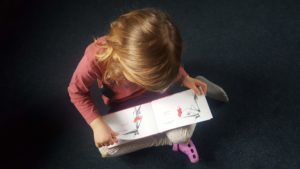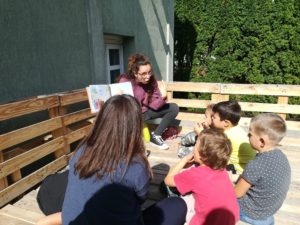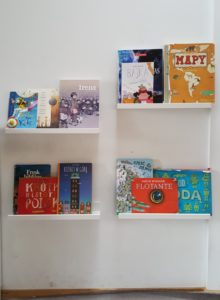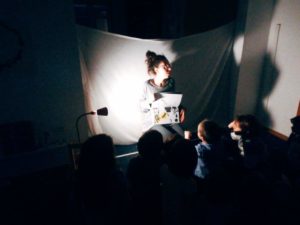LET’S READ!
Children’s Literature in School
I am Violeta, and I am doing an ESC project in the Free Democratic School Wolno Mi, in Gliwice. I love children’s literature and during my stay at the school I have been observing and participating in reading activities. This article comes from my reflection and will to explain how I experience reading culture at school.

Books, and in particular youth and children’s books, became one of my passions not a long time ago. Since then, exploring this literature has led me to discover amazing artwork that wouldn’t leave any child or adult that fell on their pages indifferent. In this way, a kind of friendship and love relationship developed between me and them.
Apart from becoming my friends, always lying on my shelf or bed before going to sleep, I believe books are also very good friends in any educational environment. They are doors to fantasy and imagination, and also to social problems, stories and knowledge that allow us to know ourselves and our world better. That is why when the educational environment promotes favourable conditions towards reading, this can easily become one of children’s favourite activities. The key to achieving that relies on these conditions. Since the educational environment involves not just school, but also family and society, building these conditions becomes a shared task among all educational agents.

In my opinion, there are three conditions that determine the creation of a favourable and rich environment towards reading. The first one is to be free to choose what to read. Reading is, first and foremost, a pleasant and personal experience. Therefore, to make someone read something against their will removes the sense from the reading experience. What we clearly can do is offer a diverse, good-quality, and wide selection of books. Readers can choose what is interesting and significant for them throughout the different stages of their reading development. Finally, a third condition is to value books, considering them as artwork as well as valuing the act of approaching them from a literary perspective. That is to say, without reducing the focus on didactic purposes or decoding processes. At all ages, books are to be valued as literary artwork and used as such. And, how to do it? By offering spaces and time to read and interact with books, creating opportunities to talk about them, to play and learn with them, reading aloud at all ages (an essential and highly pleasant activity,). All in all, doing what eventually becomes creating a reading culture at school, home or within society.

As a volunteer, I am engaged in a project at the Free Democratic School in Gliwice named Wolno Mi. There, I can experience a particular example of how reading is present and promoted in a school environment. It is a small and independent school based on the principals of freedom and respect towards natural child development. These particular characteristics define an environment that embraces the first condition described above in its fullest meaning. Children are free to choose what to read, and also when and where to read.
The result of this is undoubtedly interesting: Reading a book alone or together with others becomes a regular activity in which many of them participate every day, and at several moments throughout the day. Children always choose what they want to read from the selection provided by adults or from books they bring from home. When I walk around the rooms at school, I often find someone with a book in their hands lying on the carpet, sitting next to the window or in the hammock. It is interesting to pinpoint that I rarely see them sitting in a chair in front of a table. They are reading because they decided to, they chose a comfortable space and they will remain there until something becomes more relevant than the story, the illustrations or the material they are exploring. The interaction with the book can last between one minute up to as long as one hour. No one tells them to stop or to start reading, apart from a light suggestion now and then. This means that when I observe them reading a book, I can see that they have a reason to read that comes from their own personal interest. This in turn, makes this small reading experience a pleasant one that leads them to interpret reading as a positive and significant activity.

There is no fixed reading routine, yet I can observe two moments of the day when it is highly probable that adults and children feel like reading together. These moments are early in the morning and after lunchtime. They appear due to the children’s interest, which at these particular times on many days is to discover books, but not always. As previously mentioned, they read and interact with books at many other moments during the day. That is why I would rather say that the real routine is that reading becomes an activity they freely decide to engage in, and, what is important is that this happens very often.
Another important aspect is the value that adults, children and school give to books. Not a long time ago, we put new shelves in each room devoted to books. This is a physical way to value books, giving them importance in the organization of space. On the other hand, as I explained, adults often read aloud with children. Enjoying reading experiences together makes adults become models who value this activity, and therefore, children value it too.

My task at school involves being one more participant in this task of valuing and mediating books. I share and enjoy reading experiences with them, I bring books to the school and I try to present them to children in an interesting way. I might read the book aloud, bring some material that supports the interaction with the story or do an activity linked to it. I believe paying attention to the way we approach books is very important because it reflects the value we give them. Besides, it is an opportunity to explore artistic and creative options that books might easily invite us to discover.
Consequently, it is important to structure the strategies and ways we use to mediate books, understanding mediation as the way we bring children and books together. In the first instance, this involves making decisions about the books that are going to be mediated; one of the key conditions mentioned at the beginning. This means establishing a criteria to ensure diversity and quality in the selection we are going to build in our school, classroom or home. This selection can be formed both by our books or by books borrowed from libraries, which are a great resource. Regardless of where they come from, books which enter school must be books we want, so that adults and children want them too. That is why defining such criteria, for example taking into account what we like, what we are interested in and what makes a book quality artwork, is vitally important to ensure a rich reading environment.

On the other hand, mediating books involves very much what we do around books and literature itself; how we talk about them, promoting conversations about their literary features, the story and its subjective meaning, the feelings derived from the reading experience, etc. We can also create projects around books or invite children to recommend their favourite pieces of writing and share opinions. These are, in short, ways to make visible the potential of books, their literary interest, their influence on us and therefore, to put them in a valuable position amongst our daily activities.

I would say these proposals are examples to complement, sometimes transform, the task that schools do around reading. In the particular case I was explaining, at Wolno Mi, some of these proposals could complement the already good task that we are doing. From all the ingredients needed, I want to highlight how children in Wolno Mi can truly experience the freedom of acting and deciding about their reading experiences. I am amazed to see how this freedom is transformed into the enjoyment and interest in reading on a frequent basis by most of them. At the same time, there might be someone who rarely picks up a book. Maybe they are not interested at the moment. This is fine providing that the reason they do not want to read is simply because they have chosen not to, not because they are lacking the aforementioned conditions that define a favourable environment towards reading.

Children, all of us, deserve the freedom to choose, act, read and live. Which, ultimately, means to be happy. Educators have the duty to educate children in happiness by teaching them how to be free. Accompanying them in their growth as readers means accompanying them in their way to freedom.
Violeta Caballol Oliva



